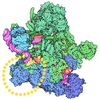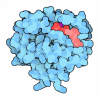[English] 日本語
 Yorodumi
Yorodumi- PDB-2kxc: 1H, 13C, and 15N Chemical Shift Assignments for IRTKS-SH3 and Esp... -
+ Open data
Open data
- Basic information
Basic information
| Entry | Database: PDB / ID: 2kxc | ||||||
|---|---|---|---|---|---|---|---|
| Title | 1H, 13C, and 15N Chemical Shift Assignments for IRTKS-SH3 and EspFu-R47 complex | ||||||
 Components Components |
| ||||||
 Keywords Keywords |  PROTEIN BINDING / IRTKS-SH3 / EspFu / Complex Structure PROTEIN BINDING / IRTKS-SH3 / EspFu / Complex Structure | ||||||
| Function / homology |  Function and homology information Function and homology informationplasma membrane organization / actin crosslink formation / cadherin binding involved in cell-cell adhesion / RHOF GTPase cycle / proline-rich region binding / positive regulation of actin filament polymerization / actin filament bundle assembly / RAC3 GTPase cycle / RAC2 GTPase cycle / RAC1 GTPase cycle ...plasma membrane organization / actin crosslink formation / cadherin binding involved in cell-cell adhesion / RHOF GTPase cycle / proline-rich region binding / positive regulation of actin filament polymerization / actin filament bundle assembly / RAC3 GTPase cycle / RAC2 GTPase cycle / RAC1 GTPase cycle / regulation of actin cytoskeleton organization /  adherens junction / adherens junction /  actin binding / host cell cytoplasm / actin binding / host cell cytoplasm /  cytoskeleton / extracellular exosome / extracellular region / cytoskeleton / extracellular exosome / extracellular region /  nucleoplasm / nucleoplasm /  plasma membrane / plasma membrane /  cytosol cytosolSimilarity search - Function | ||||||
| Biological species |   Homo sapiens (human) Homo sapiens (human)  Escherichia coli (E. coli) Escherichia coli (E. coli) | ||||||
| Method |  SOLUTION NMR / SOLUTION NMR /  molecular dynamics, TORSION ANGLE DYNAMICS molecular dynamics, TORSION ANGLE DYNAMICS | ||||||
| Model details | lowest energy, model 1 | ||||||
 Authors Authors | Aitio, O. / Hellman, M. / Kazlauskas, A. / Vingadassalom, D.F. / Leong, J.M. / Saksela, K. / Permi, P. | ||||||
 Citation Citation |  Journal: Proc.Natl.Acad.Sci.USA / Year: 2010 Journal: Proc.Natl.Acad.Sci.USA / Year: 2010Title: Recognition of tandem PxxP motifs as a unique Src homology 3-binding mode triggers pathogen-driven actin assembly Authors: Aitio, O. / Hellman, M. / Kazlauskas, A. / Vingadassalom, D.F. / Leong, J.M. / Saksela, K. / Permi, P. | ||||||
| History |
|
- Structure visualization
Structure visualization
| Structure viewer | Molecule:  Molmil Molmil Jmol/JSmol Jmol/JSmol |
|---|
- Downloads & links
Downloads & links
- Download
Download
| PDBx/mmCIF format |  2kxc.cif.gz 2kxc.cif.gz | 508.2 KB | Display |  PDBx/mmCIF format PDBx/mmCIF format |
|---|---|---|---|---|
| PDB format |  pdb2kxc.ent.gz pdb2kxc.ent.gz | 449 KB | Display |  PDB format PDB format |
| PDBx/mmJSON format |  2kxc.json.gz 2kxc.json.gz | Tree view |  PDBx/mmJSON format PDBx/mmJSON format | |
| Others |  Other downloads Other downloads |
-Validation report
| Arichive directory |  https://data.pdbj.org/pub/pdb/validation_reports/kx/2kxc https://data.pdbj.org/pub/pdb/validation_reports/kx/2kxc ftp://data.pdbj.org/pub/pdb/validation_reports/kx/2kxc ftp://data.pdbj.org/pub/pdb/validation_reports/kx/2kxc | HTTPS FTP |
|---|
-Related structure data
| Similar structure data | |
|---|---|
| Other databases |
- Links
Links
- Assembly
Assembly
| Deposited unit | 
| |||||||||
|---|---|---|---|---|---|---|---|---|---|---|
| 1 |
| |||||||||
| NMR ensembles |
|
- Components
Components
| #1: Protein | Mass: 7559.607 Da / Num. of mol.: 1 / Fragment: IRTKS-SH3 domain, UNP residues 339-402 Source method: isolated from a genetically manipulated source Source: (gene. exp.)   Homo sapiens (human) / Gene: BAIAP2L1, IRTKS / Production host: Homo sapiens (human) / Gene: BAIAP2L1, IRTKS / Production host:   Escherichia coli (E. coli) / Strain (production host): BL21(DE3) / References: UniProt: Q9UHR4 Escherichia coli (E. coli) / Strain (production host): BL21(DE3) / References: UniProt: Q9UHR4 |
|---|---|
| #2: Protein/peptide | Mass: 5301.970 Da / Num. of mol.: 1 / Fragment: EspFu-R47 domain, UNP residues 268-314 Source method: isolated from a genetically manipulated source Source: (gene. exp.)   Escherichia coli (E. coli) / Strain: O157:H7 / Production host: Escherichia coli (E. coli) / Strain: O157:H7 / Production host:   Escherichia coli (E. coli) / Strain (production host): BL21(DE3) / References: UniProt: Q8X2D5, UniProt: P0DJ89*PLUS Escherichia coli (E. coli) / Strain (production host): BL21(DE3) / References: UniProt: Q8X2D5, UniProt: P0DJ89*PLUS |
-Experimental details
-Experiment
| Experiment | Method:  SOLUTION NMR SOLUTION NMR | ||||||||||||||||||||||||||||||||||||||||||||||||||||||||||||||||||||||||||||||||||||
|---|---|---|---|---|---|---|---|---|---|---|---|---|---|---|---|---|---|---|---|---|---|---|---|---|---|---|---|---|---|---|---|---|---|---|---|---|---|---|---|---|---|---|---|---|---|---|---|---|---|---|---|---|---|---|---|---|---|---|---|---|---|---|---|---|---|---|---|---|---|---|---|---|---|---|---|---|---|---|---|---|---|---|---|---|---|
| NMR experiment |
|
- Sample preparation
Sample preparation
| Details |
| ||||||||||||||||||||
|---|---|---|---|---|---|---|---|---|---|---|---|---|---|---|---|---|---|---|---|---|---|
| Sample |
| ||||||||||||||||||||
| Sample conditions | Ionic strength: 50 / pH: 7.0 / Pressure: AMBIENT / Temperature: 298 K |
-NMR measurement
| NMR spectrometer |
|
|---|
- Processing
Processing
| NMR software |
| ||||||||||||||||
|---|---|---|---|---|---|---|---|---|---|---|---|---|---|---|---|---|---|
| Refinement | Method:  molecular dynamics, TORSION ANGLE DYNAMICS / Software ordinal: 1 molecular dynamics, TORSION ANGLE DYNAMICS / Software ordinal: 1 | ||||||||||||||||
| NMR representative | Selection criteria: lowest energy | ||||||||||||||||
| NMR ensemble | Conformer selection criteria: target function / Conformers calculated total number: 200 / Conformers submitted total number: 20 / Representative conformer: 1 |
 Movie
Movie Controller
Controller


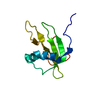


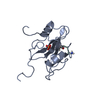

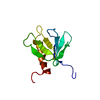
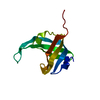
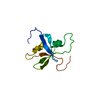
 PDBj
PDBj

